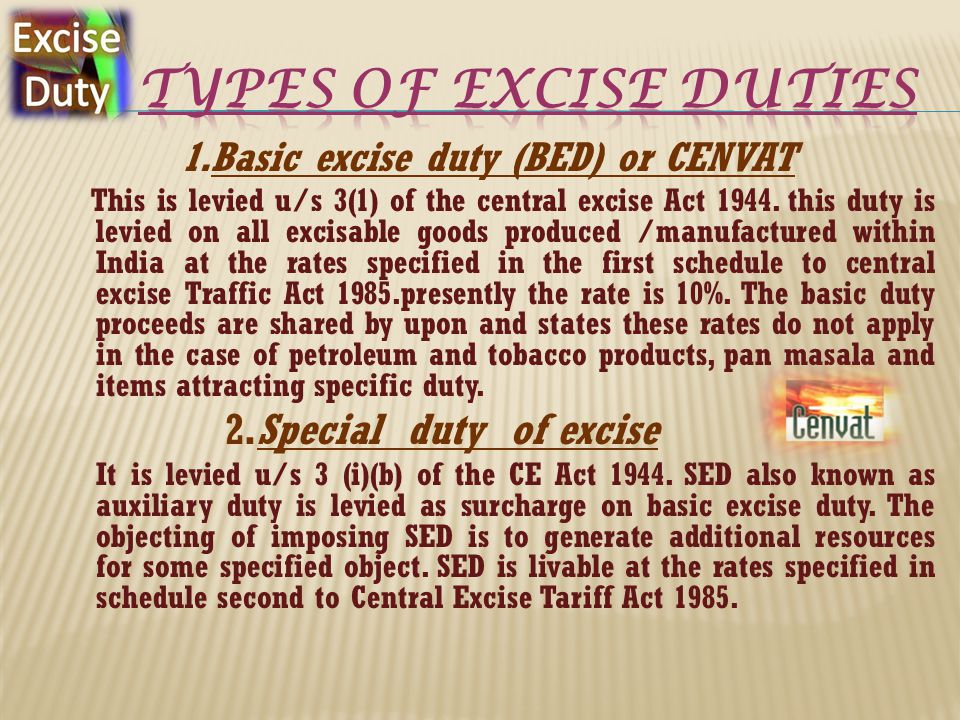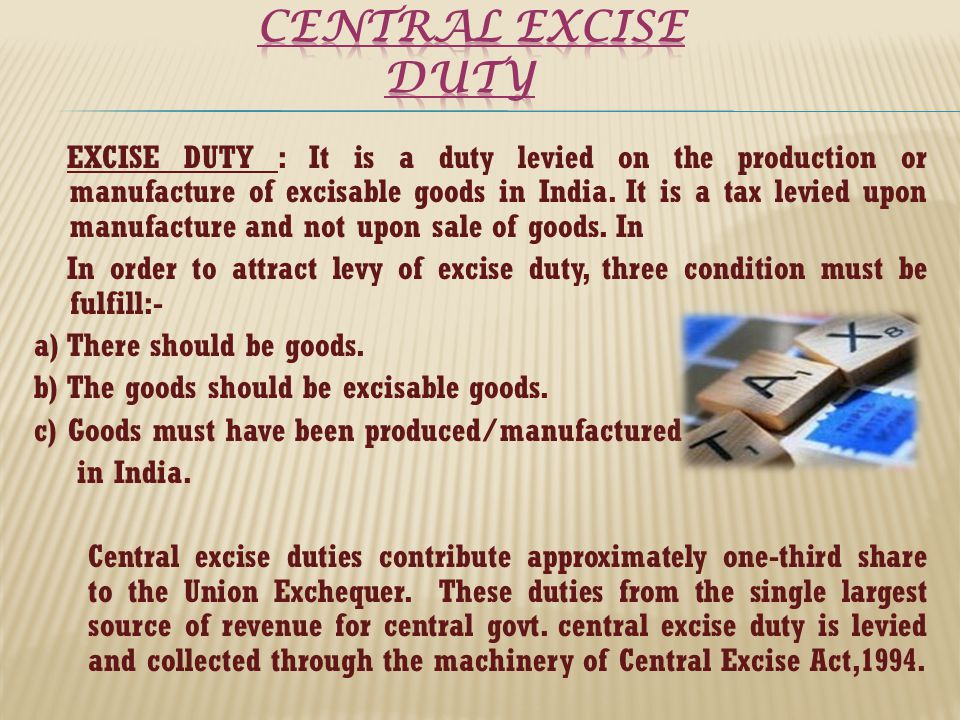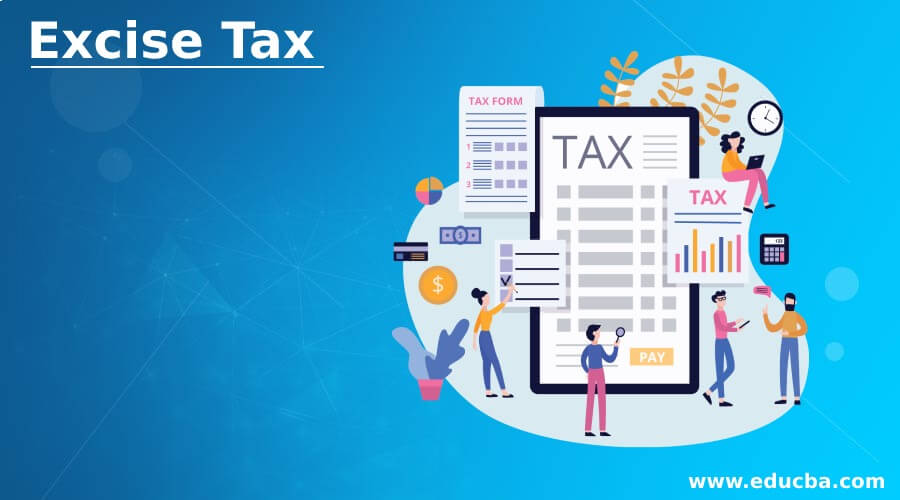Explain Different Kinds of Excise Duty in Detail
It is a tax on the production or sale of a good. On the other hand there are taxes like the specific excise taxes that are set on a particular.

Central Excise Duty Introduction And Overview Ppt Video Online Download
On some products special excise duty is imposed at 8 and on certain.

. Central GST has replaced excise duty as excise is charged by the Central Government and it also collects the revenue from Central GST. Additional Countervailing Duty of Customs. Special Excise Duty SED.
The tax is borne by the government to the manufacturers at the time of manufacturing the goods. The Central Government has the power to reduce or exempt any good from these duties. It is imposed on all excisable goods.
Excise Duty can easily be classified into two types. In India includes the territorial waters of India which extend upto 12 nautical miles into the sea to the coast of India. Customs Duty is a type of indirect tax levied on goods imported into India as well as on goods exported from India.
Basic Excise Duty also known as Central Value Added Tax CENVAT is levied at the rates specified in Central Excise Tariff Act. Explain the prevention or detection of illegally imported goods under Customs Act 1962. 2 Special Duty of Excise.
Special Excise duty SED is levied at the rates specified in Second Schedule to the Central Excise Tariff Act 1985 CETA. Explain in detail the various types of excise duty that can be imposed under Central Excise Act. As of 14th March 2020 the excise duty was 2298 per litre on petrol and 1883 per litre on diesel.
Explain in detail what Excise Import Vat and Customs duty are the impact they have on trade. As per the Section 37 of the Finance Act 1978 Special excise Duty was attracted on all excisable goods on which there is a levy of Basic excise Duty under the Central Excises and Salt Act1944. Excise duty is the tax added to the manufacturing of goods.
Excise duty is levied primarily on alcoholic beverages mineral oils and tobacco products as well as the importation of all types of vehicles in Nepal. In this case it simply means that the excise duty. Duty also known as an indirect tax is a tax levied on goods imported from another country as well as goods manufactured in the country.
Describe the functions and power of authorities relating to central excise. A number of provisions are common for excise duty and custom duty with the major difference being the place of production of the goods in question. Excise duty is paid by the producer of goods who recovers it from wholesalers and retailers.
It is imposed at the time of manufacturing and not at the time of sale unlike. In India the basic law for levy and collection of customs duty is Customs Act. Types of Excise Duty In a broader sense there are 3 distinct types of excise duty namely Basic Excise Duty This type of excise duty is levied on goods that come under schedule one of the Central Excise Tariff Act 1985.
Central Level Central Excise Duty Additional Excise Duty Service Tax Additional Customs Duty is commonly known as Countervailing Duty Special Additional Duty of Customs. On 2nd February 2021 the excise duty on diesel increased to 3180 per litre and 3290 per litre on petrol. An excise tax can be defined as a kind of indirect taxation that is applicable for goods that are produced and sold within the territorial limits of.
Taxable event is import into or export from India. Ad Valorem Excise Taxes. Custom duty is to be paid by the importer of the goods.
An excise duty is a type of tax charged on goods produced within the country as opposed to customs duties charged on goods from outside the country. Excise duty is charged on the production of goods and charged at the time of removal of products. The main difference between VAT and excise duty is that value-added tax VAT is the tax on goods when the value is added to it as it moves from the production stage to the final stage of reaching the market.
Put differently the customs duty is a kind of fee that is collected by the customs authorities for the movement of goods and services to and from that country. Special Excise Duty is. The duty may be fixed on ad -valorem basis or specific rate basis.
The duty may be a percentage of the value of the goods or at a specific rate. Answer to Explain in detail what Excise Import Vat and Customs duty are the impact they have on trade with examples on how to compute each giving advantages. Unlike sales tax which is applied to virtually every good an excise tax is only levied on particular instances including firearms telephone services medical devices indoor tanning gasoline tobacco and alcohol products jet fuel and air-fuel.
This tax in India is levied by the Central Government. The argument for increased excise duties on alcohol. When is a sale or purchase of goods said to be sale or purchase.
This percentage stands at 354 for diesel. GST on the other hand is charged on the supply of products and services. Basic excise tax is 1236 of the cost of materials consumed to prepare the goods.
Types of Excise Tax Basic Excise Tax. The central governments excise duty constitutes nearly 324 of petrols retail price. The tax that is levied for the import of products is referred to as import duty while the tax levied on the goods that are exported to some other country is known as export duty.
Excise duty is to be paid by the manufacturer of the goods and not by the consumer. Can any one pls explain what are the types of excise duties Right from purchases to selling. Ad valorem literally means as per value.
Discuss when an excise tax is likely to be used and its impact. This duty is imposed on few selected items like Pan Masala Polyester Filament Yarn Motor Cars Air conditioners tyres etc.

Central Excise Duty Introduction And Overview Ppt Video Online Download

Excise Tax Definition Types Calculation Examples


0 Response to "Explain Different Kinds of Excise Duty in Detail"
Post a Comment